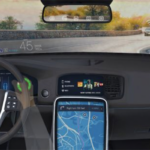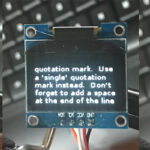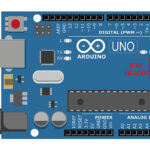 Ambarella, Inc. announced during CES the CV3 AI domain controller family. This fully scalable, power-efficient CVflow family of SoCs provides the automotive industry’s highest AI processing performance, at up to 500 eTOPS, representing a 42x increase over Ambarella’s prior automotive family. Featuring up to 16 Arm Cortex-A78AE CPU cores, the CV3 provides up to a 30x boost in CPU performance over the prior generation in support of autonomous vehicle (AV) software applications. This family enables centralized, single-chip processing for multi-sensor perception—including high-resolution vision, radar, ultrasonic, and lidar—as well as deep fusion for multiple sensor modalities and AV path planning. The result is robust ADAS and L2+ to Level 4 autonomous driving (AD) systems with greater levels of environmental perception in challenging lighting, weather, and driving conditions for both drivers viewing and machine perception.
Ambarella, Inc. announced during CES the CV3 AI domain controller family. This fully scalable, power-efficient CVflow family of SoCs provides the automotive industry’s highest AI processing performance, at up to 500 eTOPS, representing a 42x increase over Ambarella’s prior automotive family. Featuring up to 16 Arm Cortex-A78AE CPU cores, the CV3 provides up to a 30x boost in CPU performance over the prior generation in support of autonomous vehicle (AV) software applications. This family enables centralized, single-chip processing for multi-sensor perception—including high-resolution vision, radar, ultrasonic, and lidar—as well as deep fusion for multiple sensor modalities and AV path planning. The result is robust ADAS and L2+ to Level 4 autonomous driving (AD) systems with greater levels of environmental perception in challenging lighting, weather, and driving conditions for both drivers viewing and machine perception.
The CV3 marks the debut of Ambarella’s next-generation CVflow architecture, which continues the company’s algorithm-first design philosophy. This drove the development of the on-chip neural vector processor (NVP), with up to 500 eTOPS of AI compute, industry-leading power efficiency, and support for the latest advancements in neural network (NN) inferences. The NVP is also enhanced to run advanced radar perception software, such as the Oculii adaptive AI software algorithms. This is complemented by a new floating-point general vector processor (GVP) designed to offload classical computer vision and radar processing from the NVP engines, and floating-point-intensive algorithms from the Arm CPUs.
The CV3 family’s unique hardware scalability allows automakers to unify their software stacks across their entire retail portfolios while reducing the cost and complexity of software development. This scalability directly addresses the rising complexity of automotive software by providing an alternative to the fragmented ADAS SoC offerings from competitors. Additionally, the CV3 family accelerates automakers’ development timelines while simplifying the deployment of new features by providing the headroom for a single, robust over-the-air (OTA) update implementation.
This new family has multiple options to meet the product strategies of OEMs and Tier 1s, alike, from its low-power SoCs for regulatory-class, forward-facing cameras, scaling all the way to premium SoCs for Level 4 fully automated driving. This new family also supports both central and zonal architectures. In addition to covering the whole AD stack, the CV3 can simultaneously process in-cabin sensing applications, including driver and occupant monitoring. Ambarella’s complete line of AI perception SoCs is uniquely positioned to support the full range of viewing, recording, sensing and path planning applications, from basic ADAS to L4 AVs. This means that automakers no longer need to develop different software stacks for their entry-level, mid-range, and premium vehicles, as they can use Ambarella’s unified CVflow platform across all models, saving engineering costs while enabling faster responses to market trends.
Leveraging a comprehensive set of mature software tools and a robust SDK, Ambarella’s flexible CVflow AI platform provides customers with an unprecedented opportunity to innovate and differentiate their products in the marketplace. To further expand this capability, Ambarella has cultivated a broad ecosystem of software partners for the CVflow platform, working closely with them to port and optimize their applications.
The CV3 also integrates Ambarella’s next-generation ISP, extending the company’s lead in image signal processing quality. By simultaneously supporting up to 12 physical or 20 virtual cameras, a single CV3 can process the entire sensor suite, which for typical L2+ deployments includes 10 cameras, five radar modules, and numerous ultrasonic sensors. Additionally, higher-performance stereo and dense optical flow engines provide greater depth and motion perception.
Additional features of the new CV3 central domain controller family include: Automotive GPU for applications such as 3D surround-view rendering; Hardware security module, enabling the isolation of different domains and secure software provisioning; PCIe high-speed interfaces for ultra-low-latency communications; Processing headroom for OTA software updates and testing software stacks in shadow mode;
The first SoCs in the CV3 family is expected to be available for sampling during the first half of 2022.






Leave a Reply